 The Camargue Regional Natural Park (CRNP) has just published a booklet (in French) aiming to give birding enthusiasts all the information they need for watching birds in the Park: the best sites, of course, and how to get there with various means of transport, as well as where they can stay and dine in the nearby communities.
The Camargue Regional Natural Park (CRNP) has just published a booklet (in French) aiming to give birding enthusiasts all the information they need for watching birds in the Park: the best sites, of course, and how to get there with various means of transport, as well as where they can stay and dine in the nearby communities.
Because of its location along flyways and the large number of wetlands in good condition, the Camargue is an exceptional territory in terms of avifauna, which attracts amateur ornithologists and scientists from around the world. In addition to the emblematic Greater Flamingo, which has made the reputation of the Camargue, more than 400 other species of birds have been spotted here in the varous seasons, representing more than two-thirds of the total number of bird species observed in Europe.
Different kinds of trails were selected for this booklet: free access trails on sites that are not too fragile, installations on remarkable sites, featuring in some cases observation platforms, and guided visits of fragile sites that are protected. One such example is the Verdier marsh site, which is close to the hamlet of Le Sambuc. It was purchased by the Tour du Valat in 2003, and now features a highly diverse population of waterbirds.
 This document was published by the CRNP in collaboration with the other organisations involved in the management of natural areas and/or the development of sustainable tourism in the Camargue, including the Tour du Valat, the Camargue National Reserve, the Friends of the Vigueirat Marsh Association, the Pont de Gau Ornithological Park, the local nature guides office, as well as the Arles, Saintes-Maries de la Mer, and Port Saint-Louis tourist offices. It was illustrated by Cyril Girard, a naturalist artist based in the Camargue, who is also the author of a small book, “An Illustrated guide to Birds of the Camargue and Mediterranean lagoons” (nb: available in English).
This document was published by the CRNP in collaboration with the other organisations involved in the management of natural areas and/or the development of sustainable tourism in the Camargue, including the Tour du Valat, the Camargue National Reserve, the Friends of the Vigueirat Marsh Association, the Pont de Gau Ornithological Park, the local nature guides office, as well as the Arles, Saintes-Maries de la Mer, and Port Saint-Louis tourist offices. It was illustrated by Cyril Girard, a naturalist artist based in the Camargue, who is also the author of a small book, “An Illustrated guide to Birds of the Camargue and Mediterranean lagoons” (nb: available in English).
You can download the booklet for free from the Camargue Regional Natural Park website (here opposite).
Contact :
Capucine Ser, Tourism Officer at the Camargue Regional Natural Park (contact [1])
